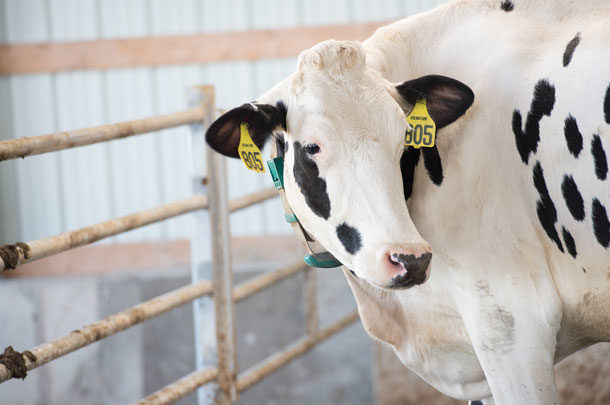“Pregnant.” Hearing that word during herd check is music to every dairy farmer’s ears.
And it should be. Getting cows bred back in timely fashion delivers dollars to the bottom line. Using activity monitoring systems can improve reproductive performance – delivering more calls of “pregnant” – through real-time data.
Activity monitors record cow activity 24-7, and some also monitor neck movements such as sniffing and chin resting to indicate if a cow is in heat. The goal: Use this data to find the optimal breeding time, typically six to 16 hours after peak activity. These systems continually survey the herd, recording data and providing accurate, real-time information.

Data-based recommendations for breeding times can enhance insemination results to improve conception, increase pregnancy rates, reduce calving intervals and cut insemination costs – all with less labor.
Real herds, real results
Herds across the country are using activity monitoring systems and seeing improvements in reproductive performance. Here’s a look at three herds and their results (see Table 1).

Herds often see changes in reproductive performance shortly after implementing activity monitors. Once a system is installed and collars are on, it takes about a couple of weeks to establish an activity baseline for each animal in the herd. Many farms notice a decrease in days open and hours spent breeding almost immediately after the system baseline is established and you are up and running.
Plan your day with custom reports
You should be the one controlling the data with activity monitoring systems. Each system is unique, but the most common use of data is tracking activity (for heats) and reviewing the breeding list each morning. The breeding list report can be printed from your computer or viewed on your mobile device, along with individual cow data. The systems can even alert you by email – cow by cow – when ready to breed, which can work well for smaller herds. For larger herds, individual cow alerts can be overwhelming; viewing computer reports once or twice a day is typically most convenient.
Look for a system that can rank your cows by optimal breeding time to keep your repro program running efficiently. If you have 20 to 30 cows on your breeding list for the day, you can start breeding cows in priority order to help ensure the most optimal window for insemination. If you’re running tight on time, you can use the ranked list to determine if cows lower on the list could be bred the following morning. The data puts you in control and helps you plan your day.
Data should also be customizable. With some systems, you can filter out cows within your defined voluntary waiting period to keep them from showing up on reports. Or you can keep them in the report so you know they are cycling and ready to breed when the time comes. It all can be customized to your management style.
Use labor more effectively
Activity monitoring systems allow you to save time and use labor more effectively by:
- Eliminating the need for someone to watch for heats during the day. If you’re spending eight hours per day watching for heats and breeding, you can scale that time back and concentrate on breeding tasks. The monitoring system tracks heats more accurately over time than the human eye.
- Reducing or eliminating labor devoted to synchronization programs, such as Ovsynch. Many farms replace synchronization programs with activity monitoring, while some farms use synchronization programs for only a small percentage of the herd after putting in activity monitors. Labor is reduced by removing time for administering shots on top of hormone costs. An additional benefit is less time requiring cows to be locked up for shot administration.
Increased labor efficiency allows you to reallocate time and energy to other farm tasks that have a bigger impact on your herd.
Secondary health benefits
Most activity monitoring systems track more than heats. Eating and rumination time are key measures to identify health problems like mastitis, ketosis, rumen acidosis and lameness. Eating and rumination data points allow you to identify sick cows sooner – for earlier intervention to reduce treatment costs and maintain milk production.
Many herds who purchase activity monitors for heat detection quickly realize health monitoring brings incredible benefits to their herd management.
Seeing the ROI
Each farm is unique, but many herds realize paybacks as fast as a year and a half into using a complete cow monitoring system.
If you’re replacing a reproduction synchronization program, you’ll likely see a return faster. And if you already have a high-quality repro program, it will give you the tools to take you to the next level. Remember, the return on investment (ROI) goes beyond reproduction with the health monitoring data that helps you catch and treat more cow issues sooner.
Work with your milking equipment dealer to improve your herd’s reproductive performance with an animal monitoring system – they can ensure it properly integrates with your parlor identification.






